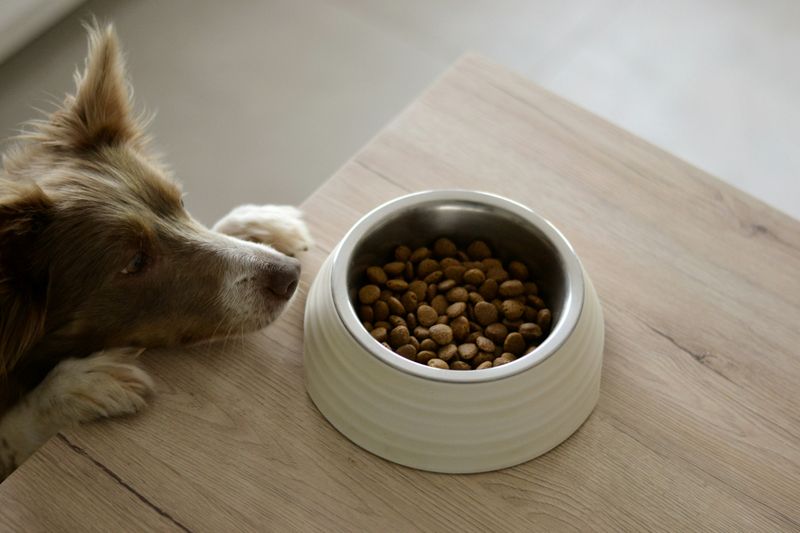Your dog is part of the family, and you want to feed them right. However, choosing the right dog food isn’t just about grabbing the prettiest bag off the shelf — it’s a big decision that affects your dog’s energy, health, and even lifespan.

With so many flashy labels and fancy claims, it’s easy to feel overwhelmed in the pet food aisle.
Follow these tips to:
Choose the right dog food based on your dog’s unique needs
Make sense of labels
Steer clear of common traps
Homemade vs. Store-Bought
Nowadays, more and more dog owners are exploring homemade meals. It can work great if done carefully. But for beginners or busy dog parents, store-bought dog food might be the most practical choice.

Homemade Dog Food
Ingredients: owners have full control over what goes in
Nutrition balance: requires careful planning & vet consultation
Convenience: time-consuming to prep and cook
Cost: can be expensive, depending on ingredients
Variety: customizable, but requires time and effort

Store-Bought Dog Food
Ingredients: pre-formulated and standardized to regulations like AAFCO
Nutrition balance: designed to be complete & balanced
Convenience: easier to store, serve, and buy
Cost: wide range of prices to fit your budget
Variety: comes in dry, wet, freeze-dried, raw, etc.
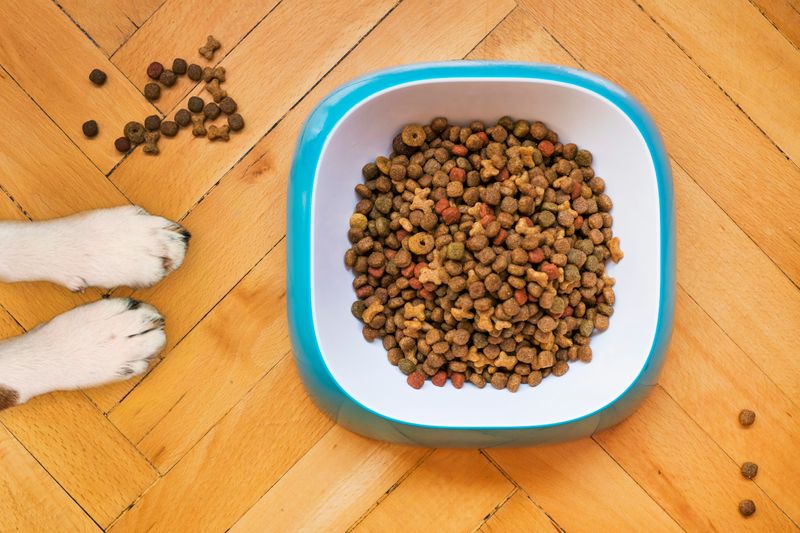 Photo by Mathew Coulton on Unsplash
Photo by Mathew Coulton on UnsplashMost dog owners prefer the convenience of prepared food, but check out this recipe if you want to try making your own dog food.
Understand Your Dog’s Needs
Just like humans, dogs don’t all thrive on the same diet. Their ideal food depends on several key factors.
 Age:
Age:
Puppies need food that supports growth and brain development, with higher protein and fat.
Adult dogs require maintenance diets with balanced nutrients.
Senior dogs may need fewer calories, plus ingredients that support joints and digestion.
 Size:
Size:
Small breeds (under 10 kg / 22 lbs): These dogs burn energy faster and often need calorie-dense food in smaller kibble sizes. (e.g. Chihuahua, Pomeranian, Toy Poodle)
Medium breeds (10–25 kg / 22–55 lbs): These dogs have moderate energy needs and usually do well with standard kibble sizes. (e.g. Beagle, Border Collie, Cocker Spaniel)
Large breeds (over 25 kg / 55 lbs): These dogs are more prone to joint issues and benefit from food with controlled calcium and phosphorus. (e.g. Labrador Retriever, Golden Retriever, Great Dane)
 Activity Level:
Activity Level:
High-energy dogs: These dogs burn a lot of energy and may need higher-protein, calorie-rich food to stay healthy and strong. (e.g. Border Collie, Australian Shepherd, Belgian Malinois, Jack Russell Terrier)
Low-energy dogs: These pups are prone to weight gain and do better on lower-calorie diets. (e.g. Bulldog, Basset Hound, Shih Tzu, senior dogs of any breed)
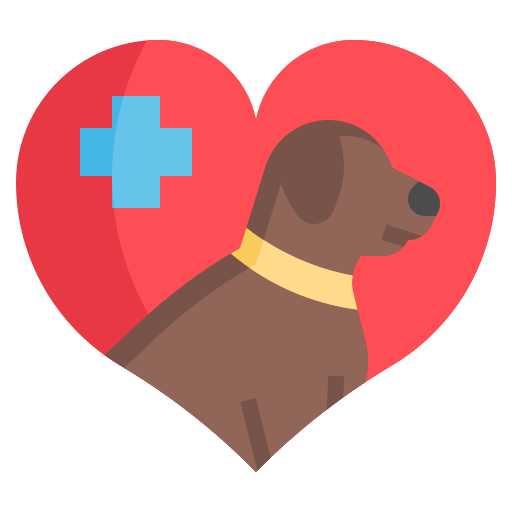 Health Conditions:
Health Conditions:
Dogs with allergies may need grain-free or limited-ingredient diets.
Dogs with obesity, kidney disease, or diabetes may require prescription formulas tailored to those needs.
Quiz
Coco is a 10-year-old Chihuahua who prefers naps over long walks. Which type of food would be most appropriate for her?
How to Read a Dog Food Label
Dog food labels can be tricky — but learning to spot key info can help you make the right choice for your pup. There’s a lot of information on the label.
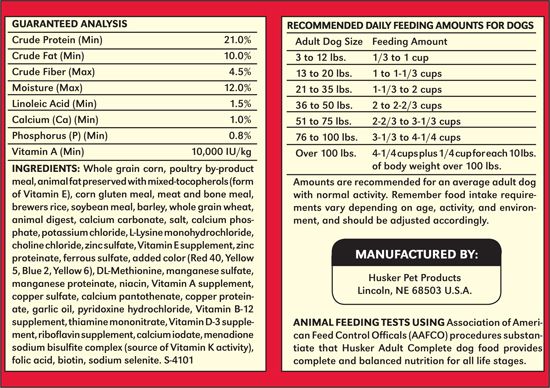 Image courtesy of the University of Nebraska-Lincoln
Image courtesy of the University of Nebraska-Lincoln
Here’s what to look for:
Check the first ingredient.
Ingredients are listed by weight. The first one is the most important because it's what the food is mostly made of.
Look for real meat like chicken, beef, lamb, or salmon.
Avoid vague terms like “meat by-products” as the main ingredient.
Look for whole, recognizable ingredients.
After the protein, the food should include:
Whole grains (like brown rice, oats)
Fruits and vegetables (like sweet potatoes, carrots)
Healthy fats (like fish oil or flaxseed oil)
“Complete and balanced” is key.
This phrase means the food contains all the nutrients dogs need at a certain life stage (like puppy, adult, or senior). Look for a statement like:
“This food is complete and balanced for adult maintenance”.
“Formulated to meet the nutritional levels established for growth”.
Check the guaranteed analysis.
This is a small box on the label that shows percentages of key nutrients, like:
Protein for muscle
Fat for energy
Fiber for digestion
Moisture for water content
Review feeding guidelines.
These are suggested daily serving amounts based on dog weight. They’re helpful starting points but should be adjusted based on your dog’s needs and vet advice.
Quiz
What should be listed first in the ingredients of good-quality dog food?
Avoid Common Red Flags
When shopping for dog food, don’t get fooled by shiny packaging or clever marketing. Watch out for these red flags:

Artificial ingredients: Things like fake colors, flavors, or preservatives (e.g., BHA, BHT) aren’t necessary and can be harmful in the long run. ❌
Buzzwords without substance: If a label says it has “superfoods” like blueberries or kale, check the ingredient list. If they’re listed at the bottom, the amount is tiny and won’t make a real difference. ❌
Unclear meat sources: “Meat meal” or “animal by-product” sounds mysterious for a reason. If it doesn’t say what kind of meat (like “chicken meal”), skip it. ❌
Corn or wheat as the first ingredient: These are cheap fillers. Your dog deserves real meat first. ❌

Quiz
Which of the following are red flags when choosing dog food? Select all that apply:
Don’t Fall for Dog Food Fads
Not every trendy dog diet is right for your pup. While some special diets can be helpful, they’re not meant for every dog!
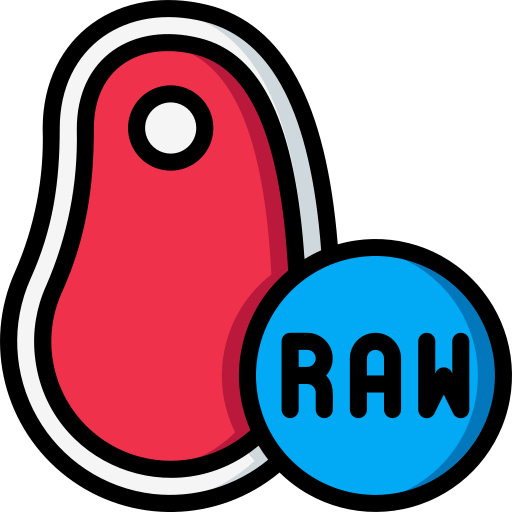
Raw food diets may appeal to owners seeking “natural” options, but they require strict handling to avoid harmful bacteria like Salmonella and E. coli, which can affect both dogs and humans.

Grain-free food might seem healthier, but most dogs digest grains just fine. Some grain-free diets have even been linked to heart problems in dogs. It’s not that all grain-free diets are inherently harmful, but they have raised concerns.

Veterinary diets are specially formulated for medical conditions like kidney disease or allergies, but they’re not meant for healthy dogs and should only be used when prescribed.

Tip: Marketing can make anything sound magical, but your dog’s health depends on real facts. Always check with your vet before switching to a special diet.
Take Action
Choosing the right dog food isn’t just about labels, it’s about giving your dog the happiest, healthiest life possible. Remember: A great diet = a healthy, happy dog!

Feeling overwhelmed? Don’t worry — take action with these simple steps:
Your feedback matters to us.
This Byte helped me better understand the topic.


